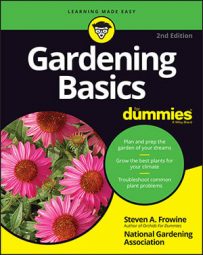Feeding (fertilizing) flowers keeps plants healthy and rewards you with great color and blossoms. But too much fertilizer can be bad for your plants, and applying the wrong type can be counterproductive.
Plants have complex systems in need of chemicals to help them produce their own foods. The three primary plant-growth elements, or nutrients, are as follows:
N (nitrogen): Enhances stem and leaf growth (for most plants, nitrogen ends up being the most important nutrient)
P (phosphorus): Contributes to flower production, fruit production, seed production, and root growth
K (potassium): Ensures general vigor; helps plants resist disease
An all-purpose, balanced formulation contributes to overall plant health. These top three nutrients are usually listed on the back labels of bags of fertilizer that you can buy in any garden supply store. They're usually listed in order as numbers on the package (N-P-K). A balanced fertilizer (one that contains the three most important elements — nitrogen, phosphorus, and potassium) may show up as 5-10-5 or even 5-10-10. Nitrogen-heavy lawn fertilizer usually has a high first number. You can find are plenty of other variations, depending on the intended use of the fertilizer.
A fertilizer label often tells you which kind of fertilizer is best for your particular garden. If in doubt about your garden's exact needs, talk to someone at your local garden nursery or supply store.
Unless you're fertilizing with compost, more is not better! Constantly fertilizing lousy soil isn't a good idea. Not only is it a lot of work and expense for you, but it's also a losing battle. Salts build up, plants are never really healthy in the long term, and the soil texture remains poor. You're far better off increasing the organic matter and using fertilizer as a nutrient boost for your plants.
"Feed the soil, not the plants!" is an old gardening adage, and frankly, these are words to live by. At least once a year, and more often if the opportunity presents itself, dig in organic matter, add it to every planting hole (except when planting trees and shrubs), top-dress, and side-dress.
The only way to know which fertilizer you should use is through personal trial and error. That said, you need to know a few things about natural and chemical fertilizers to help you make your decision. Check out the following for a side-by-side comparison.
| Trait | Natural Fertilizers | Chemical Fertilizers |
|---|---|---|
| Form | Are organically based; examples include compost (homemade or store-bought), manure, fish emulsion, cottonseed meal, bloodmeal, bonemeal, and liquid seaweed | Come in various forms, including granules, powders, and concentrated liquids; examples include bagged and boxed fertilizers in various formulations, including Miracle-Gro and Osmocote. |
| Cost and maintenance | Pound for pound, are generally more expensive in terms of the amount of fertilizer they provide, but they also improve the soil and tend to last longer than chemical fertilizers | Are usually affordable and easy to maintain |
| Effects on soil | Tend to improve soil texture and quality | Do not contribute to long-term soil fertility |
| Presence of secondary nutrients and micronutrients | Can include beneficial minor elements | May or may not contain these nutrients; check the label |
| Effect on organisms | Feed helpful soil organisms | Usually have a neutral effect |
| Rate of release | Tend to release nutrients slowly, so plants aren't damaged, but results aren't always as dramatic | Fast-acting way to jump-start plant performance but must be applied correctly so they don't injure or burn your plants; special slow-release chemical fertilizers are the exception |
Whether you're using store-bought or natural fertilizer, such as compost or manure, most plants like to be fertilized at planting time. Thereafter, fertilize again on a monthly basis. Reduce or stop when fall's cooler weather arrives.
If you're using store-bought or chemical fertilizer, read the label to figure out how to deliver the fertilizer and how much to use. Some fertilizers work best if you dig them right into the soil; others are better delivered in dilute form when you water. The label can also tell you how much to use per square foot of garden area and how often to apply. For bagged organic fertilizer, read the label; otherwise, do some research on your own.

